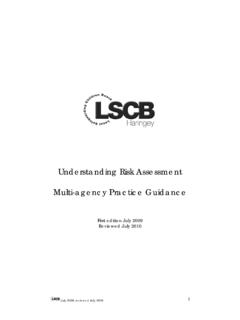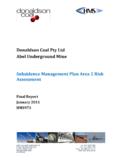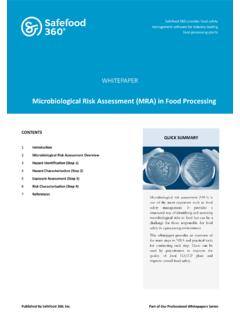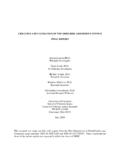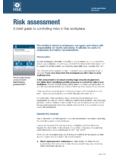Transcription of Risk assessment of - Food and Agriculture …
1 M I C R O B I O L O G I C A L R I S K A S S E S S M E N T S E R I E S. 5. Risk assessment of Listeria monocytogenes in ready-to-eat foods TECHNICAL REPORT. WORLD HEALTH ORGANIZATION. FOOD AND Agriculture ORGANIZATION OF THE UNITED NATIONS. 2004. For further information on the joint FAO/WHO. activities on microbiological risk assessment , please contact: Food Quality and Standards Service Food and Nutrition Division Food and Agriculture Organization of the United Nations Viale delle Terme di Caracalla I-00100 Rome, Italy Fax: +39 06 57054593. : Web site: or Food Safety Department World Health Organization 20, Avenue Appia CH-1211 Geneva 27. Switzerland Fax: +41 22 7914807. : Web site: Cover design : Food and Agriculture Organization of the United Nations and the World Health Organization. Cover picture: Dennis Kunkel Microscopy, Inc. The designations employed and the presentation of the material in this publication do not The designations employed and the presentation of the material in this publication do not imply the expression of any opinion whatsoever on the part of the World Health Organization nor of the Food and Agriculture Organization of the United Nations concerning the legal or development status of any country, territory, city or area or of its authorities, or concerning the delimitation of its frontiers or boundaries.
2 The views expressed herein are those of the authors and do not necessarily represent those of the World Health Organization nor of the Food and Agriculture Organization of the United Nations nor of their affiliated organization(s). The World Health Organization and the Food and Agriculture Organization of the United Nations do not warrant that the information contained in this publication is complete and shall not be liable for any damage incurred as a result of its use. WHO Library Cataloguing-in-Publication Data Risk assessment of Listeria monocytogenes in ready-to-eat foods : technical report. (Microbiological risk assessment series ; no. 5). 1. Listeria monocytogenes - pathogenicity monocytogenes growth and development contamination handling assessment - methods infections Health Organization and Agriculture Organization of the United Nations ISBN 92 4 156262 5 (WHO) (LC/NLM classification: QW ). ISBN 92 5 105 127 5 (FAO).
3 ISSN 1726-5274. All rights reserved. Requests for permission to reproduce or translate the material contained in this publication . whether for sale or for non-commercial distribution - should be addressed to the Chief, Publishing Management Service, Information Division, Food and Agriculture Organization of the United Nations, Viale delle Terme di Caracalla, 00100 Rome, Italy, or by e-mail to or to Publications, Marketing and Dissemination, World Health Organization, 20 Avenue Appia, CH-1211 Geneva 27, Switzerland, or by facsimile to +41 22 791 4806, or by e-mail to WHO / FAO 2004. iii . CONTENTS. Acknowledgements xiii Risk assessment Drafting Group xv Reviewers xvii Foreword xxi Abbreviations used in the text xxiii EXECUTIVE SUMMARY xxv PART 1. HAZARD IDENTIFICATION. Historical 1. Characteristics of Listeria monocytogenes 1. Overview of listeriosis 2. Statement of problem and scope of risk assessment 5. PART 2. HAZARD CHARACTERIZATION.
4 Listeriosis 7. Manifestations of listeriosis 7. Systemic listeriosis 8. Febrile gastroenteritis 11. Foods associated with foodborne listeriosis 11. Dose-response relations 12. Characterization of severity and the selection of appropriate biological end points to be modelled 12. Factors that affect dose-response relations for L. monocytogenes 13. Virulence of L. monocytogenes isolates 13. Host susceptibility 17. Food matrix effects 19. Interaction of pathogen, host and matrix variables 20. Approaches to modelling dose-response relations 21. General approaches and limitations to modelling dose-response relations for foodborne pathogens 21. Listeria monocytogenes dose-response models developed from epidemiological data and expert elicitations 28. Listeria monocytogenes dose-response models developed from data derived from surrogate pathogens or surrogate animals 35. Listeria monocytogenes dose-response models developed from data derived from a combination of surrogate animal and epidemiological data 40.
5 Iv . Options for hazard characterizations to be used for modelling the public health impact of L. monocytogenes in ready-to-eat foods 50. Exponential dose-response model used in the present risk assessment 51. Overview of the estimation of parameter r in the exponential dose- response model 52. Dose-response models for healthy and susceptible population 55. Differences in susceptibility to listeriosis for different human populations. 59. r-values for Risk Characterization 59. PART 3. EXPOSURE assessment . Introduction 65. Exposure Data 67. Introduction 67. Prevalence 68. Modelling Exposure: Approaches 68. Introduction 68. Prevalence and concentration 70. Conceptual model 71. Mathematical models 71. Point estimates 72. Distributions and stochastic approaches 74. Simulation modelling 75. Uncertainty and variability 75. Modelling the Production-to-Consumption Chain 76. Environmental niche 76. Preharvest 76. Production 76. Processing and packaging 77.
6 Transportation 77. Retail 77. Home and foodservice 78. Microbial Ecology of Listeria monocytogenes in Foods 78. Introduction 78. Growth limits 79. Growth: rate, lag and maximum population density 79. Growth rate 79. Maximum concentration 82. Lag phases or recovery from injury 82. Death or inactivation 83. v . Death rates 83. Thermal inactivation 84. Freezing 84. Non-thermal inactivation 85. Summary 86. PART 4. EXAMPLE RISK ASSESSMENTS. Overview 87. Introduction 87. Approaches taken 87. Choice of example risk assessments 88. Example 1: Fluid milk 88. Example 2: Ice cream 88. Example 3: Semi dry fermented meats 89. Example 4: Cold-smoked fish 89. Common elements used in risk assessments 89. Definition of risks that were calculated 89. Simulation modelling 89. Estimation of consumption 90. Temperature data 90. Dose-response modelling 91. Example 1. Pasteurized milk 91. Statement of purpose 91. Hazard identification 91. Exposure assessment results 92.
7 Prevalence of L. monocytogenes at retail in pasteurized milk 92. Concentration of L. monocytogenes in contaminated milk at retail 92. Growth of L. monocytogenes in milk 94. Growth rate of L. monocytogenes in milk 94. Pasteurized milk storage temperature 94. Pasteurized milk storage time 95. Concentration of L. monocytogenes in contaminated milk at consumption 95. Consumption characteristics for milk 96. Simulated L. monocytogenes in contaminated pasteurized milk at consumption 98. Risk characterization 98. Annual illnesses per 100 000 population 98. Illnesses per 1 000 000 servings 99. Uncertainty and variability 99. Effects of hazard characterization's dose-response 99. Effects of estimated consumption frequency 99. Effects of estimated consumption amounts 100. vi . Effects of L. monocytogenes prevalence on risks of listeriosis 100. Effects of L. monocytogenes concentration at retail 101. Effects of higher storage temperatures 102.
8 Effects of longer storage times 103. Effects of growth 104. Example 2. Ice cream 104. Statement of purpose 104. Hazard identification 104. Exposure assessment results 105. Prevalence of L. monocytogenes at retail 105. Concentration of L. monocytogenes at retail 107. Growth of L. monocytogenes in ice cream 107. Consumption characteristics for ice cream 107. Risk characterization 110. Annual illnesses per 100 000 population 110. Illnesses per 1 000 000 servings 111. Uncertainty and variability 111. Effects of hazard characterization's dose-response 111. Effects of estimated consumption frequency 112. Effects of estimated consumption amounts 112. Effects of L. monocytogenes prevalence 112. Effects of L. monocytogenes concentration at retail 113. Example 3. Fermented Meat 114. Statement of purpose 114. Hazard identification 114. Exposure assessment 114. Production and Consumption 114. Modelling exposure 115. Risk characterization 120.
9 Uncertainty and variability 123. Example 4: Cold-smoked fish 124. Statement of purpose 124. Hazard identification 124. Exposure assessment 126. Production and consumption of smoked fish products 126. Contamination rates and levels 126. Time and temperature of storage 127. Physico-chemical parameters of cold-smoked fish 127. Growth potential and microbial ecology of vacuum-packed products 127. Exposure assessment model 128. vii . Risk characterization 130. Introduction 130. Assumed variables 130. Results 131. Uncertainty and variability 131. Consumption 131. Effect of other microbiota 132. Reality check 132. Summary 133. PART 5. RISK CHARACTERIZATION: RESPONSE TO CODEX QUESTIONS. Introduction 135. Question 1 135. Question 2 140. Question 3 143. Growth rates in foods 143. Comparison of four foods 144. What-if scenarios 145. Milk 145. Smoked Fish 146. Summary 148. PART 6. KEY FINDINGS AND CONCLUSIONS. Key findings and conclusions 149.
10 PART 7. REFERENCES CITED. References cited in main report 153. APPENDICES. APPENDIX 1. GLOSSARY OF TERMS 179. APPENDIX 2. SIMULATION MODELLING FOR THE FOUR RISK assessment EXAMPLES 185. Introduction 185. Modelling the exposure assessment 185. Overview 185. Non-susceptible and susceptible populations 188. viii . Consumption characteristics 190. Ice cream and Fluid milk, pasteurized modules 191. Prevalence and concentration 193. Prevalence characteristics 194. Concentration characteristics 194. Correlated prevalence and concentration 195. Storage characteristics 195. Growth 198. Growth characteristics 199. Growth conditions 199. Study indices 202. Consumption characteristics 202. Overview 202. The data 203. Non-susceptible and susceptible populations 205. Home storage characteristics 206. Home refrigeration temperatures 206. Home storage times 207. Storage time and temperature 208. Growth characteristics 208. Introduction 208.










